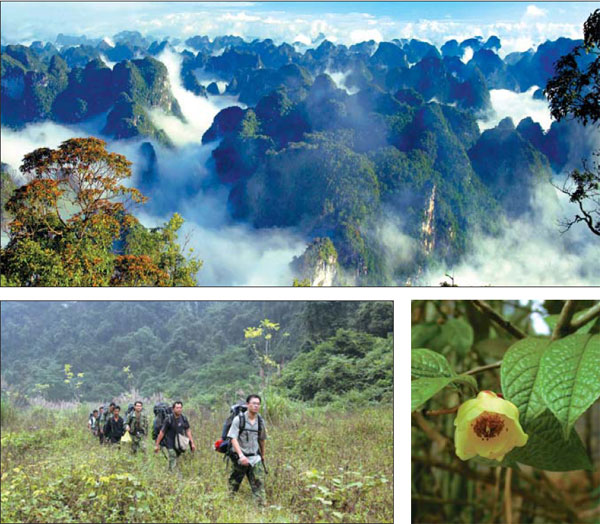Nature's nirvana
Updated: 2013-03-13 09:46
By Chen Liang (China Daily)
|
||||||||
 |
|
Clockwise from top: A panoramic view of the Nonggang reserve. A blossoming golden camellia flower. Rangers on the way for their patrol and monitoring work. Photos Provided to China Daily |
Better protection
The director attributes the discoveries to the reserve's better protection.
About 80 rangers are working at six protection stations. Now they use GPS devices and cameras. Data from their daily patrols and monitoring are input into computer and used for the reserve's geographic information system, which is still under construction.
Although about 14,000 people live around the reserve's 63 villages, cases of poaching protected animals are scarce, Meng says.
"Probably several poaching cases of tokay gecko (Gekko gecko - a nocturnal gecko known for its alleged medicinal value) or gamebirds in a year," he says. "No one dares to hunt such protected animals as monkeys."
Since rangers re-discovered white-headed langurs in the reserve in 2004, they have put the critically endangered monkey under regular monitoring and strict protection.
In 2007, there were only 68 white-headed langurs in eight families. In 2012, a total of 88 individuals in 10 families lived on limestone cliffs of the reserve. "The largest family had 12 individuals," the director says.
Francois' langur, another endangered primate, was distributed in the reserve with 10 families of 64 individuals in 2006. In 2012, the population increased to 14 families of 97.
Oriental hornbill, a large-sized bird with a long, down-curved bill, disappeared for more than 20 years and returned last year. A family of six hornbills has even begun frequenting three big trees at Nonggen village near the reserve since last March.
"This year they have increased to nine birds, eight in a family, one a loner," says Chen Weiqiang, a villager. "They usually come in the early morning. Not afraid of us, they can be very noisy sometimes."
New threats
Although such traditional threats as poaching have become less serious, some new threats have started bothering the reserve managers.
The golden camellia (Camellia chrysantha) is a plant species known for its beautiful flowers, found only in China and Vietnam. Of its 23 varieties, 21 can be found in China and six are spread across Nonggang.
Before 2010, they were just rare ornamental plants, blossoming and withering quietly in forests. "After the flowering season, golden camellia blossoms covered the forest floor in some areas, rotting," Chen Tianbo says. "We often turned a blind eye to them."
Since 2010, some companies in Guangxi have begun to hype up the flower's "magical health benefits", Meng says. "Anti-aging, anti-cancer, similar to the alleged effects of caterpillar fungus or matsutake mushroom," he explains.
As a result, a kilogram of dried wild golden camellia flowers is priced more than 10,000 yuan ($1,607). Half a kilogram of fresh flower is priced at 400 yuan on the local market. A bonsai created with a wild golden camellia tree can be sold for half a million yuan.
"Outside collectors came to Longzhou and some locals would sneak into our reserve at night mainly for flowers, sometimes for trees," he says. "During the flower season, our rangers are exhausted just trying to keep illegal collectors at bay."
Other new threats are macaques and wild boars.
The monkey, a dominant animal in Nonggang with a population of more than 1,000, lives on cliffs, but often feeds close to villages. "A family of macaques often has more than 100 members," Meng says. "When they come, they can easily consume and destroy the crop of a whole plot of field. Wild boars are just as destructive as the monkey."
The increasing conflicts between wildlife and villagers have also become a major problem faced by the reserve managers. "Our compensation fund is very limited. To be honest, we haven't found a good solution yet," the director adds.
Contact the writer at chenliang@chinadaily.com.cn.

 'Taken 2' grabs movie box office crown
'Taken 2' grabs movie box office crown
 Rihanna's 'Diamonds' tops UK pop chart
Rihanna's 'Diamonds' tops UK pop chart
 Fans get look at vintage Rolling Stones
Fans get look at vintage Rolling Stones
 Celebrities attend Power of Women event
Celebrities attend Power of Women event
 Ang Lee breaks 'every rule' to make unlikely new Life of Pi film
Ang Lee breaks 'every rule' to make unlikely new Life of Pi film
 Rihanna almost thrown out of nightclub
Rihanna almost thrown out of nightclub
 'Dark Knight' wins weekend box office
'Dark Knight' wins weekend box office
 'Total Recall' stars gather in Beverly Hills
'Total Recall' stars gather in Beverly Hills
Most Viewed
Editor's Picks

|

|

|

|

|

|
Today's Top News
Boston bombing suspect reported cornered on boat
7.0-magnitude quake hits Sichuan
Cross-talk artist helps to spread the word
'Green' awareness levels drop in Beijing
Palace Museum spruces up
First couple on Time's list of most influential
H7N9 flu transmission studied
Trading channels 'need to broaden'
US Weekly

|

|







